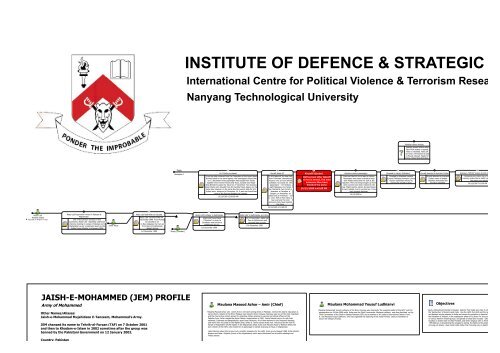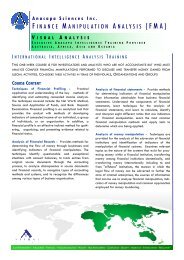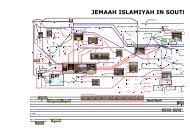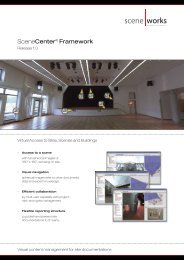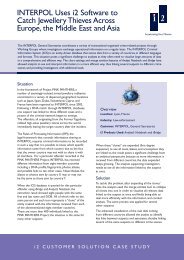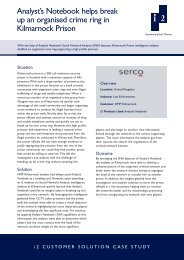Indian Airlines Hijacking - Visual Analysis
Indian Airlines Hijacking - Visual Analysis
Indian Airlines Hijacking - Visual Analysis
Create successful ePaper yourself
Turn your PDF publications into a flip-book with our unique Google optimized e-Paper software.
Abdul Latif<br />
Mumbai (India)<br />
Reported as "KingPin" in India<br />
Abdul Latif reportedly trained in Pakistan &<br />
Afghanistan<br />
One of the persons arrested in this<br />
connection, Abdul Latif reportedly underwent<br />
intensive training in camps in Pakistan and in<br />
Afghanistan as per a statement given by the<br />
<strong>Indian</strong> Home Minister in 6 January 2000.<br />
'Chief' Athar<br />
Aeroplane 1<br />
Shaqir ('Shankar')<br />
JAISH-E-MOHAMMED (JEM) PROFILE<br />
Army of Mohammed<br />
Other Names/Aliases:<br />
Jaish-e-Mohammad Mujahideen E-Tanzeem, Mohammed's Army.<br />
JEM changed its name to Tehrik-al-Furqan (TAF) on 7 October 2001<br />
and then to Khadam-e-Islam in 2002 sometime after the group was<br />
banned by the Pakistani Government on 12 January 2002.<br />
Country: Pakistan<br />
Abdul Latif and Athar to Calcutta<br />
Abdul Latif escorted Athar on 1<br />
November 1999 from Mumbai<br />
to Calcutta by air<br />
, to New Jalpaiguri by train and<br />
from there to Kathmandu<br />
(Nepal) by bus<br />
1st November 1999<br />
INSTITUTE OF DEFENCE & STRATEGIC ST<br />
International Centre for Political Violence & Terrorism Research<br />
Nanyang Technological University<br />
Air Tickets purchased<br />
From the data retrieved from the Computers of the Royal Nepal<br />
<strong>Airlines</strong> linked to the travel agents, the investigators found that<br />
on 13 December three passengers had bought their tickets<br />
together from Everest Travels and Tours, located near Nepal<br />
King Birendra's palace for travel on 27 December. Two business<br />
class tickets were brought from the Gorkha Travel Agency on the<br />
same day. However on the same day the journey date for all 5<br />
tickets were advanced to December 24. It was also found that<br />
none of the five had booked any luggage.<br />
13/12/1999 12:00:00 AM<br />
Abdul Latif & Shaqir to Kathmandu<br />
Abdul Latif took Shaqir<br />
('Shankar') by train to<br />
Gorakhpur and further to<br />
Kathmandu by bus.<br />
1st December 1999<br />
Abdul Latif to Kathmandu and return<br />
On 17 December Abdul Latif<br />
flew to Kathmandu and<br />
returned later by train.<br />
17th December 1999<br />
Aircraft takes off<br />
IC-814 takes off for New Delhi<br />
from Tribhuvan International<br />
Airport, over an hour behind<br />
schedule. On board are 178<br />
passengers -- 154 <strong>Indian</strong>s,<br />
eight Nepalese, four Swiss,<br />
four Spaniards, two French, a<br />
Japanese, a Canadian, a<br />
Belgian, an Australian, an<br />
Italian and an American -- and<br />
11 crew. Half an hour later, as<br />
tea is served, five men<br />
announce they have hijacked<br />
the plane.<br />
24/12/1999 4:15:00 PM<br />
Aircraft hijacked<br />
Half an hour after takeoff<br />
as tea is served, five men<br />
announce they have<br />
hijacked the plane.<br />
24/12/1999 4:45:00 PM<br />
Hijackers control passengers<br />
Flies over the city on its way to Lahore.<br />
Passengers have been ordered to keep<br />
their heads bowed and not look at the<br />
hijackers. Men are being brought up front<br />
while women have been ordered to the<br />
rear. Flight reaches Lahore but permission<br />
to land refused. Fuel is running low. Turns<br />
back towards Amritsar.<br />
24/12/1999 w<br />
Maulana Masood Azhar – Amir (Chief) Maulana Mohammad Yousuf Ludhianvi<br />
Maulana Masood Azhar, who comes from a rich land-owning family in Pakistan, received his Islamic education at<br />
Jamia Uloom-i-Islami at the Binori Mosque near Karachi. Binori mosque madrassa was one of the most important<br />
and the most active centers known for imparting military training by serving and retired officers of the<br />
Pakistan Army. Azhar passed the almia (Islamic) examination in 1989. Jamia Islamia had on its rolls Arab<br />
nationals, Sudanese and Bangladeshis, apart from Pakistanis. All of them believed in the Deobandi ideology,<br />
and many were recruited for the Afghan jihad. While at Jamia Islamia Azhar was influenced by the work of<br />
Harkat-ul-Mujahideen (HUM) leaders in the Afghanistan jihad. Azhar met Maulana Fazal-ul-Rahman Khalil, the<br />
Amir (Chief) of the HUM, who invited him to participate in tarbiat (training) at Yavar, in Afghanistan.<br />
Later Rahman asked him to bring out a monthly magazine for the HUM. From around August 1989, Azhar started<br />
bringing out Sada-i-Mujahid (Knock of the Mujahideen) which were distributed free at public meetings and<br />
Friday prayers.<br />
After the formation of the Harkat-ul-Ansar ( HUA)by merging the Harkat-ul-Jehad Islami (HUJI) and HUM in 1994,<br />
Azhar became its general secretary and was told to visit Kashmir to ensure union among the chief commanders of<br />
both outfits in Kashmir, ascertain the ground position, boost morale of cadre, and resolve any differences<br />
between HUJI and HUM. Azhar landed in Delhi by a Bangladesh Biman flight that arrived from Dhaka early on the<br />
morning of 29 January 1994 traveling on a Portuguese passport.<br />
Diverted to Lahore (Pakistan)<br />
Diverted by hijackers towards<br />
Lahore (Pakistan) however Lahore<br />
Airport authorities refused to<br />
permit the aircraft to land.<br />
Maulana Mohammad Yousuf Ludhianvi of the Binori mosque was reportedly “the supreme leader of the JEM,” until his<br />
assassination on 18 May 2000 while Azhar was the Chief Commander. Maulana Ludhianvi was also described as the<br />
Chief Commander of the Sipah-e-Sahaba Pakistan (SSP) and a member of bin Laden's International Islamic Front.<br />
It was Maulana Yousuf Ludhianvi, who had organized the hijacking of the <strong>Indian</strong> <strong>Airlines</strong> plane to Kandahar to<br />
secure the release of Azhar.<br />
Pakistan allows landing<br />
Pakistan allows landing after<br />
New Delhi makes a request.<br />
Plane is refuelled. Takes off<br />
for Oman. Permission to land<br />
in Muscat refused. Heads for<br />
Dubai, United Arab Emirates.<br />
Aircraft diverted to Amristar (India)<br />
Aircraft diverted to Amristar<br />
(India) where it landed.<br />
Hijackers demanded the<br />
aircraft is refuelled.<br />
Objectives<br />
Unknown "official" orders aircraft is refuelled<br />
Someone who claims he is from the home<br />
ministry orders the air traffic control to refuel<br />
the plane over telephone.<br />
24/12/1999 7:01:00 PM<br />
Jaish-e-Mohammad intends to liberate Kashmir from India and unite it with Pakistan. Its o<br />
the 'destruction' of America and India. Like the HUM, the HUJI and the Lashkar –e-Toiba<br />
and Kashmir as the gateway to India and retains the ambition to liberate Muslims in other<br />
the liberation of Kashmir, in the subsequent phase of its jihad. For this purpose it aims to<br />
of various Kahmiri militant groups. Its agenda on jihad also includes taking control of th<br />
Ayodhya in <strong>Indian</strong> state of Uttar Pradesh, and other religious sites in Amritsar in Punjab a<br />
JEM believes in broadening the struggle by taking the battle to the people of India. Its s<br />
carrying out attacks deep inside India rather than focusing only on Kashmir.
IC STUDIES<br />
search<br />
"official" orders aircraft is refuelled<br />
eone who claims he is from the home<br />
ry orders the air traffic control to refuel<br />
the plane over telephone.<br />
24/12/1999 7:01:00 PM<br />
om India and unite it with Pakistan. Its objectives also include<br />
UM, the HUJI and the Lashkar –e-Toiba (LET), JEM projects Jammu<br />
the ambition to liberate Muslims in other parts of India after<br />
e of its jihad. For this purpose it aims to work for unification<br />
jihad also includes taking control of the Babri Masjid in<br />
er religious sites in Amritsar in Punjab and New Delhi.<br />
g the battle to the people of India. Its strategy also envisions<br />
n focusing only on Kashmir.<br />
Male passengers stabbed, aircraft departs<br />
Cabinet Secreatary calls to advise the plane<br />
should not be refuelled. The hijackers start<br />
stabbing selected male passengers. Rupin<br />
Katyal, a 25-year-old honeymooner, dies.<br />
Plane takes off with fuel for just 30 minutes.<br />
Heading is for Lahore (Pakistan).<br />
24/12/1999 7:06:00 PM<br />
Aircraft departs<br />
Aircraft leaves for<br />
Kabul. Destination<br />
changed to Kandahar<br />
en route.<br />
25/12/1999 8:01:00 AM<br />
History and Development<br />
Jaish-e-Mohammed (JeM) is a relatively new organisation but has turned out to be amongst the deadliest terrorist outfits<br />
operating in South Asia. JEM was officially launched on 31 January 2000 by Maulana Masood Azhar in Karachi in Pakistan<br />
after he was released by <strong>Indian</strong> authorities as part of the terrorists for hostage swap of 31 December 1999 following<br />
the hijacking of the <strong>Indian</strong> <strong>Airlines</strong> Flight 814. Prior to the formation of JEM, Maulana Masood Azhar was the general<br />
secretary of the Harkat-ul-Ansar (HUA) which was formed in 1994 by the merger of Harkat-ul-Mujahideen (HUM) and<br />
Harkar-ul-Jihad Islami (HUJI). Azhar was on a mission in Jammu and Kashmir under pseudonym Essa Bin Adam on a Portuguese<br />
passport when he was arrested by the <strong>Indian</strong> security forces. It was HUA, which planned and executed the hijacking of<br />
the <strong>Indian</strong> <strong>Airlines</strong> flight. The hijackers involved were Ibrahim Athar, (brother of Masood Azhar) , Shahid Akhtar Sayed,<br />
Sunny Ahmed Qazi, Mistri Zahoor Ibrahim, Shakir, all from Pakistan. When Azhar was released, the HUA had already<br />
been included in the US list of Foreign Terrorist Organizations (FTOs), which compelled its constituent groups to<br />
resume their pre-merger identities as HUM and HUJI. However, Masood Azhar decided to float a new outfit, primarily<br />
due to differences with Fazlur Rahman Khalil, the chief of HUM, over management of funds. Khalil was also getting<br />
increasingly uncomfortable with Azhar’s strong and virulent anti-Shia tendencies. Azhar announced the formation of<br />
Jaish-e-Mohammed (JEM) from the Darul Uloom Islamia Binori Town mosque in Karachi, one of the largest religious<br />
seminaries in Pakistan and one of the most influential centres of hard-line Deobandi Sunni Muslim ideology in the<br />
world. Near about three quarters of Harakat ul-Mujahedin (HUM) members defected to the new organization.<br />
The formation of the outfit was endorsed by three religious school chiefs in Pakistan, namely, Mufti Nizamuddin Shamzai<br />
THE HIJACKING OF IC - 814<br />
Al Qaeda, Taliban and Pakistani Factor<br />
Aircraft lands at Lahore (Pakistan)<br />
India persuaded the Pakistani authorities to<br />
permit the aircraft to land. The aircraft nearly<br />
crash-landed and was surrounded by Pakistani<br />
commandos. It was refueled and headed for<br />
Kabul<br />
Aircraft refuelled<br />
It was refueled and headed for Kabul. But<br />
because of the lack of night-landing facilities<br />
there, and later, at Kandahar, the plane was<br />
diverted towards Dubai. It finally landed at the<br />
Al-Minhat air force base<br />
Group Affiliations<br />
25 passengers released<br />
. The hijackers demanded food,<br />
medicines and a step ladder. The<br />
UAE officials agreed to negotiate if<br />
the women and children are<br />
allowed to disembark. The<br />
hijackers released 25 passengers,<br />
and allowed the body of Katyal to<br />
be released to the UAE<br />
authorities.<br />
25/12/1999 w<br />
After its formation in January 2000, JEM reportedly became a member of the Army of Islam, a clandestine group<br />
raised in Pakistan with support of the official establishment to fight against the Soviet troops in Afghanistan<br />
during the anti-Soviet jihad. Under this umbrella organization JEM maintained links with Harakat ul-Mujahedin (HUM),<br />
Lashkar-e-Toiba (LET) Al Badr, and Al Qaeda.<br />
Jamaat-i Ulema-i Islam (JUI-F)<br />
JUI-F is a mainstream radical and reportedly pro-Taliban political party in Pakistan. JUI-F chief, Maulana Fazlur<br />
Rahaman was a personal friend of Mullah Omar and bin Laden. Maulana Masood Azhar, the chief of JEM maintains extensive<br />
contacts with Maulana Fazlur Rahaman.<br />
Lashkar-e-Omar:<br />
Lashkar-e-Omar is believed to be a clandestine conglomerate of 3 militants groups- Harkar-ul-Jihad Islami (HUJI),<br />
Harkat-ul Mujhahideen (HUM) and JEM which surfaced in 2002 in Pakistan.<br />
Al Qaeda:<br />
JEM leader, Maulana Masood Azhar reportedly fought along with Al Qaeda against the US troops in Somalia in 1994 and<br />
had participated in the training of Al Qaeda's supporters in Yemen. Many of the HUM cadres who joined JEM received<br />
training in the camps set in Afghanistan by Al Qaeda, especially in Rishkhor near Kabul. When the US led coalition’s<br />
Meeting 9<br />
On the morning of 25 December 1999, the<br />
flight took off from Dubai for Afghanistan and<br />
landed at the Kandahar airport at 0855 hrs.<br />
The hijackers demanded the release Mohammad<br />
Masood Azhar along with 35 other jailed<br />
terrorists and US $200 million and that the<br />
body of Harkat-ul-Ansar chief in Jammu &<br />
Kashmir Sajjad Afghani be exhumed and the<br />
coffin be handed over to them for the release<br />
of 154 hostages. Later they dropped their<br />
demands for a $200 million ransom and the<br />
exhumed remains.<br />
25/12/1999 w<br />
Aircraft lands, first demands issued<br />
Lands at 0833. Hijackers make<br />
their first demand. They want<br />
Maulana Masood Azhar, a<br />
militant in <strong>Indian</strong> custody,<br />
released. Erick de Mul, a UN<br />
official based in Islamabad,<br />
flies to Kandahar on a<br />
'humanitarian' mission.<br />
26/12/1999 8:33:00 AM<br />
Area of Operation<br />
Passenger Anil Khurana is released<br />
Anil Khurana, a sick passenger, is released.<br />
26/12/1999 3:41:00 PM<br />
JEM is based in Peshawar and Muzaffarabad, (Pakistan). The group, however conducts terrorist activities and operations<br />
primarily in the state of Jammu and Kashmir, India. The only instance of its operations outside Jammu and Kashmir has<br />
been the 13 December, 2001 attack against the <strong>Indian</strong> Parliament in New Delhi. JEM maintained training camps in<br />
Afghanistan and reportedly ran bases in Azad Kashmir (Pakistan Occupied Kashmir), Pakistan, and India's Doda and southern<br />
regions in Jammu and Kashmir.<br />
JEM maintained offices in Pakistan and in Pakistan Occupied Kashmir (POK) and in some areas of Jammu and Kashmir in<br />
India. As per the information compiled by <strong>Indian</strong> intelligence sources, the central office of the JEM, which was earlier<br />
in Islamabad , has now been shifted to Bahawalpur.<br />
Old Address:<br />
House No. 868, I-10/4,<br />
Main Road,<br />
Near Kalid Hospital Stop,<br />
Islamabad.<br />
Ph. No. 051-4432400<br />
New Address:<br />
Plane refuelled.<br />
1621: Afghanistan says it will not<br />
allow any military operation to<br />
rescue hostages. Plane is<br />
refuelled.<br />
26/12/1999 4:21:00 PM<br />
Unknown Associate<br />
in Pakistan<br />
Latif was<br />
instructed to call<br />
London Television<br />
Correspondent<br />
Radio contact with hijackers<br />
An <strong>Indian</strong> diplomat<br />
makes radio contact<br />
with the hijackers.<br />
27/12/1999 1:40:00 PM<br />
Organizational/Command Structure<br />
Jaish-e-Mohammad maintains a centralized hierarchical structure. It has a network of organizing units in v<br />
such as Punjab, Karachi, Rawalpindi, Gujjarkhan etc. The head of the JEM is Amir. There are functional de<br />
the ones responsible for propaganda, Finance, Military Affairs, POK (Pakistan Occupied Kashmir) Affairs an<br />
It has sector commands (different territories organized as sectors) and camps (training/logistics) each ma<br />
commanders.<br />
As per the last available information, the organizational/command system of JEM was structured around th<br />
office bearers located at its headquarters in Pakistan:<br />
Maulana Masood Azhar – Amir (Chief)<br />
Conditions on aircraft<br />
deteriorate<br />
Hostages given<br />
breakfast. Condition<br />
aboard plane, which is<br />
ready for take off but<br />
leaking oil,deteriorates.<br />
27/12/1999 10:12:00 AM<br />
Maulana Qari Mansoor Ahmed – Nazim, Propaganda Wing<br />
Maulana Abdul Jabbar – Nazim, Military Affairs (Former Nazim Military Affairs, (HuM)<br />
Maulana Sajjad Usman – In-charge, Finance (Former HuM Nazim Finance)<br />
Mufti Mohammad Uwais Kashmiri- In-charge POK (Pakistan Occupied Kashmir) Affairs
Radio contact with hijackers<br />
An <strong>Indian</strong> diplomat<br />
makes radio contact<br />
with the hijackers.<br />
27/12/1999 1:40:00 PM<br />
called<br />
arrested<br />
Arrested<br />
arrested<br />
The call was intercepted which led to the arrest in Mumbai<br />
of accomplice Abdul Latif (who received the call),<br />
Mohammed Rehan, Mohammed Iqbal (both Pakistanis)<br />
and Yusuf Nepali, a citizen of Nepal.<br />
arrested<br />
arrested<br />
arrested<br />
Kumar Bhugel<br />
Harkat-ul-Ansar (HUA)<br />
d Structure Financial<br />
Training<br />
Operational<br />
It has a network of organizing units in various provinces<br />
the JEM is Amir. There are functional departments such as<br />
K (Pakistan Occupied Kashmir) Affairs and publications.<br />
) and camps (training/logistics) each manned by launching<br />
system of JEM was structured around the following prominent<br />
itary Affairs, (HuM)<br />
Finance)<br />
14<br />
tors<br />
ied Kashmir) Affairs<br />
Hijackers threaten to kill<br />
hostages<br />
<strong>Hijacking</strong> date advanced 3<br />
days<br />
Hijackers threaten to<br />
kill hostages if their<br />
demand is not met by<br />
1234 hours.<br />
27/12/1999 11:34:00 AM<br />
The date of the<br />
hijacking originally<br />
planned for 27<br />
December was<br />
advanced by three<br />
days.<br />
27/12/1999 12:00:00 PM<br />
Hjijackers deadline<br />
The deadline<br />
passes without<br />
incident.<br />
27/12/1999 12:34:00<br />
PM<br />
Source of Supply:<br />
<strong>Indian</strong> Officials arrive Kandahar.<br />
<strong>Indian</strong> officials arrive in<br />
Kandahar.<br />
27/12/1999 6:32:00 PM<br />
Direct negotiations with<br />
hijacker commence<br />
They begin their first<br />
direct talks with the<br />
hijackers, which<br />
continue into the<br />
early hours of<br />
Tuesday.<br />
27/12/1999 10:56:00 PM<br />
Most of the JEM's material resources (weapons etc) have been drawn from the militant groups Harakat ul-Jihad al-Islami (HUJI)<br />
and the Harakat ul-Mujahedin (HUM). Most of the JEM's cadre belonged to Harakat ul-Jihad al-Islami (HUJI) and the Harakat<br />
ul-Mujahedin (HUM).<br />
India has claimed that Pakistan's Inter Services Intelligence pays JEM militants, with the recruits being paid approximately<br />
$8,500 - $10,630 over a two-year period, half of which is paid in advance to a recruit's family, with the rest collected<br />
upon completion of contract. Pakistan, however had denied such charges.<br />
Al Rasheed Trust, one of the many ostensibly humanitarian relief organizations, which received extensive financial backing<br />
from some Western and Saudi intelligence agencies during the Afghan jihad was suspected to be a funding source for the group.<br />
The Al-Rasheed Trust is based in Karachi, Pakistan, and was originally set up as a welfare organisation. In the 1980s,<br />
it was co-opted to channel Saudi Arabian funds to Afghan mujahideen. The trust paid compensation to the families of those<br />
killed in the Afghan 'jihad'. After the Soviets withdrew from Afghanistan, the Trust's focus shifted to Kashmir in India<br />
to finance insurgency in that state. When Maulana Masood Azhar was released in December 1999, he was put in charge of<br />
handling the Trust's assets. Though Azhar maintained the Trust's links with the Taliban, he expanded the concept of jihad<br />
to include Kashmir. The Trust has openly funded Kashmiri mujahideen and paid compensation to their families.<br />
Telephone calls from hijacked aircraft lead to arrests<br />
On 29 December, the hijackers contacted one of their associates in Pakistan who in<br />
turn called a Mumbai (India) number. The accomplice in Mumbai was told to inform a<br />
television correspondent in London to put out the news that the plane would be blown<br />
up if the demands were not met. The call was intercepted which led to the arrest in<br />
Mumbai of accomplice Abdul Latif (who received the call), Mohammed Rehan,<br />
Mohammed Iqbal (both Pakistanis) and Yusuf Nepali, a citizen of Nepal. Latif apparently<br />
was the kingpin at the <strong>Indian</strong> end, having escorted 'Chief' Athar on 1 November 1999<br />
from Mumbai to Calcutta by air, to New Jalpaiguri by train and from there to<br />
Kathmandu (Nepal) by bus. Exactly a month later he took Shaqir ('Shankar') by train to<br />
Gorakhpur and further to Kathmandu by bus. Then on 17 December he flew to<br />
Kathmandu and returned later by train. The date of the hijacking originally planned for<br />
27 December was advanced by three days.<br />
29/12/1999 12:00:00 PM<br />
Military Capability<br />
Hijackers reduce demands<br />
India begins fourth round<br />
of negotiation.<br />
Hijackers drop demand for<br />
money and return of slain<br />
militant's body.<br />
29/12/1999 4:06:00 PM<br />
Mohammed Rehan<br />
Pakistani<br />
Mohammed Iqba<br />
Pakistani<br />
Yusuf Nepali<br />
Nepalese<br />
allegedly<br />
supplied<br />
weapons<br />
JEM has several hundred armed cadres located in Pakistan Occupied Kashmir, (POK), and in India's southern Kashmir and Doda regions.<br />
Following Maulana Masood Azhar's release from detention in India, three quarters of Harakat ul-Mujahedin (HUM) members reportedly<br />
defected to the new organization. JEM has also managed to attract a large number of urban Kashmiri youth from <strong>Indian</strong> state of<br />
Jammu and Kashmir. Its cadre also include Afghans and Arab veterans of the Afghan war. The group uses light and heavy<br />
machineguns, assault rifles, mortars, improvised explosive devices, and rocket grenades. As revealed from many of its high<br />
profile attacks, i.e. October 2001 attacks against the Jammu and Kashmir Legislative Assembly and December 2001 attacks against<br />
the <strong>Indian</strong> Parliament, the group is capable of planning, coordinating and executing operations involving sensitive and even<br />
highly protected targets. This has been a factor of the level of training that the group members received in Afghan Training camps.<br />
The group appears to be well versed in using modern information systems like mobile/satellite phones, Internet etc for communication.<br />
In a statement issued in Srinagar on 4 February 2002, a JEM spokesperson asserted that the group has in its possession as much<br />
ammunition as was required to fight against India for next five years.<br />
<strong>Indian</strong> security forces believe that the JEM, with its small but committed network, was capable of daring attacks both under<br />
day and night conditions.<br />
Afroz<br />
Account in Bombay<br />
user of<br />
Negotiations almost breakdown<br />
"Intense round" of direct talks nearly<br />
breaks down completely. Additional Taleban<br />
troops surround plane. But talks are<br />
resumed later.<br />
Another sick hostage is released. He<br />
returns to plane after treatment.<br />
External Affairs Minister Jaswant Singh<br />
says talks are "extremely delicately<br />
poised."<br />
30/12/1999 2:00:00 AM<br />
Afroz receives flight training<br />
Afroz clocked 100 hours of flying in the<br />
southern city of Melbourne in Australia<br />
on a single engine twin-seat Cessna<br />
152 and Piped Warrior 28 planes<br />
between August 1997 and 1998. He<br />
returned to Bombay in 1998.<br />
<strong>Indian</strong> investigators believe that Afroz's<br />
family was too poor to pay for the more<br />
than $100,000 in fees needed for the<br />
classes. They believe that the cost of<br />
Afroz's training in Melbourne was borne<br />
by the Student's Islamic Movement of<br />
India (SIMI) SIMI a banned <strong>Indian</strong><br />
group linked to many high profile<br />
attacks in India<br />
Maulana Mansur Ilyas<br />
ANZ Grindlays Bank account in New Delhi<br />
sent<br />
US $ 20000<br />
Investigators also traced remittance of<br />
about a million <strong>Indian</strong> rupees (about US $<br />
20000) to Afroz's account in Bombay from<br />
an ANZ Grindlays Bank account in New<br />
Delhi.<br />
received<br />
Hijackers leave airport in vehicle<br />
Though India accused that all the hijackers were<br />
Pakistanis and went back to Pakistan after they were<br />
released from the custody of the Taliban, Pakistan had<br />
vehemently refuted the charges. Reappearing in Karachi<br />
Massod Azhar gave an account of what happened after<br />
the vehicle carrying the hijackers, the three freed<br />
prisoners and a hostage from Afghanistan's ruling<br />
Taliban militia left Kandahar airport on December 31.<br />
"The hijackers said, 'You don't know us. We have never<br />
met. We are from India, and we respect you and admire<br />
you but we cannot take off our masks." Azhar also said<br />
that all three including Mushtaq Ahmed Zargar, and<br />
Ahmed Umar Saeed Sheikh, crossed together into<br />
Pakistan from Afghanistan. But the hijackers released<br />
the Taliban hostage -- taken to guarantee their safe<br />
passage out of the airport -- and said they were<br />
returning to India. Azhar asserted that the hijackers<br />
were <strong>Indian</strong> citizens from Kashmir.<br />
31/12/1999 12:00:00 AM<br />
Afroz meets with Ilyas<br />
While in Australia, Afroz regularly<br />
met with Maulana Mansur Ilyas, the<br />
leader of the Verribia Islamic Centre<br />
in the Victoria State. Security<br />
agencies believe Ilyas to be Al<br />
Qaeda's regional leader in Australia.<br />
JEM cadres were mostly trained in Madrassas in Pakistan known for imparting military training by serving and retired officers of the<br />
Pakistan Army. Many of its members were also trained by Al-Qaeda and related organizations in Afghanistan. JEM chief Massod<br />
Azhar himself received training in Yemen with Al Qaeda members in 1994. JEM reportedly maintained training camps in Afghanistan<br />
during the Taliban regime (Rishkhor for example) until at least June 2000 when its cadres were expelled from Afghanistan by the<br />
Taliban after some of its members were convicted on charges of rape and murder. However, there were reports about some of the<br />
JEM cadres being trained in Afghanistan especially persons involved in very high profile missions such as attacks against the<br />
Jammu and Kashmir Legislature in Srinagar and <strong>Indian</strong> Parliament in New Delhi in October and December 2001 respectively. India<br />
has claimed that Pakistan's Inter Services Intelligence (ISI) recruits and trains terrorist belonging to groups such as the JEM<br />
before dispatching them across the line of control (LoC)<br />
Ideology<br />
According to <strong>Indian</strong> intelligence sources, JEM cadres were being trained in camps located at Kahuta, Hazira, Rawalkot JEM in is Pakistan an extremely militant and vio<br />
and Palandri opposite Poonch, Aliabad, Putwal and Sialkot opposite Jammu, Zaffarwal, Dudhniyal and Kel opposite the from Kupwara India and its union with Paki<br />
sector and in camps north of the Kargil area in the state of Jammu and Kashmir in India.<br />
from Jammu and Kashmir. It is poli<br />
a mainstream political grouping un<br />
JEM operated a large training camp at Balakot in the North West Frontier Province (NWFP), in Pakistan, run by Yousuf, is reflected a christain from its predisposition t<br />
convert from Sindh province I Pakistan who is married to Azhar’s sister, to impart training in batches of 800-1000 trainees. and stay away from education. In p<br />
but to stay away from un-Islamic w<br />
Recruits from Malaysia and possibly Singapore were believed to have been trained in the offices of the Jaish-e-Mohammad cutting in hair the and against cooperating<br />
Binori madrassa complex in Karachi<br />
As Maulana Masood Azhar, chief of<br />
According to a report prepared by Pakistani intelligence in early 2003, the JEM military training camps in Batrasi andJammu<br />
and Kashmir. We have lakhs<br />
Syed Ahmad Shaeed in Manshera and Balaskots were still functional and running even after the group was banned in freedom January struggle 2002. by adopting such<br />
struggle of Kashmiris and we thus<br />
so we would not stop Jihad at any<br />
Ideological Keywords<br />
Politico-religious and, irredentist , A


